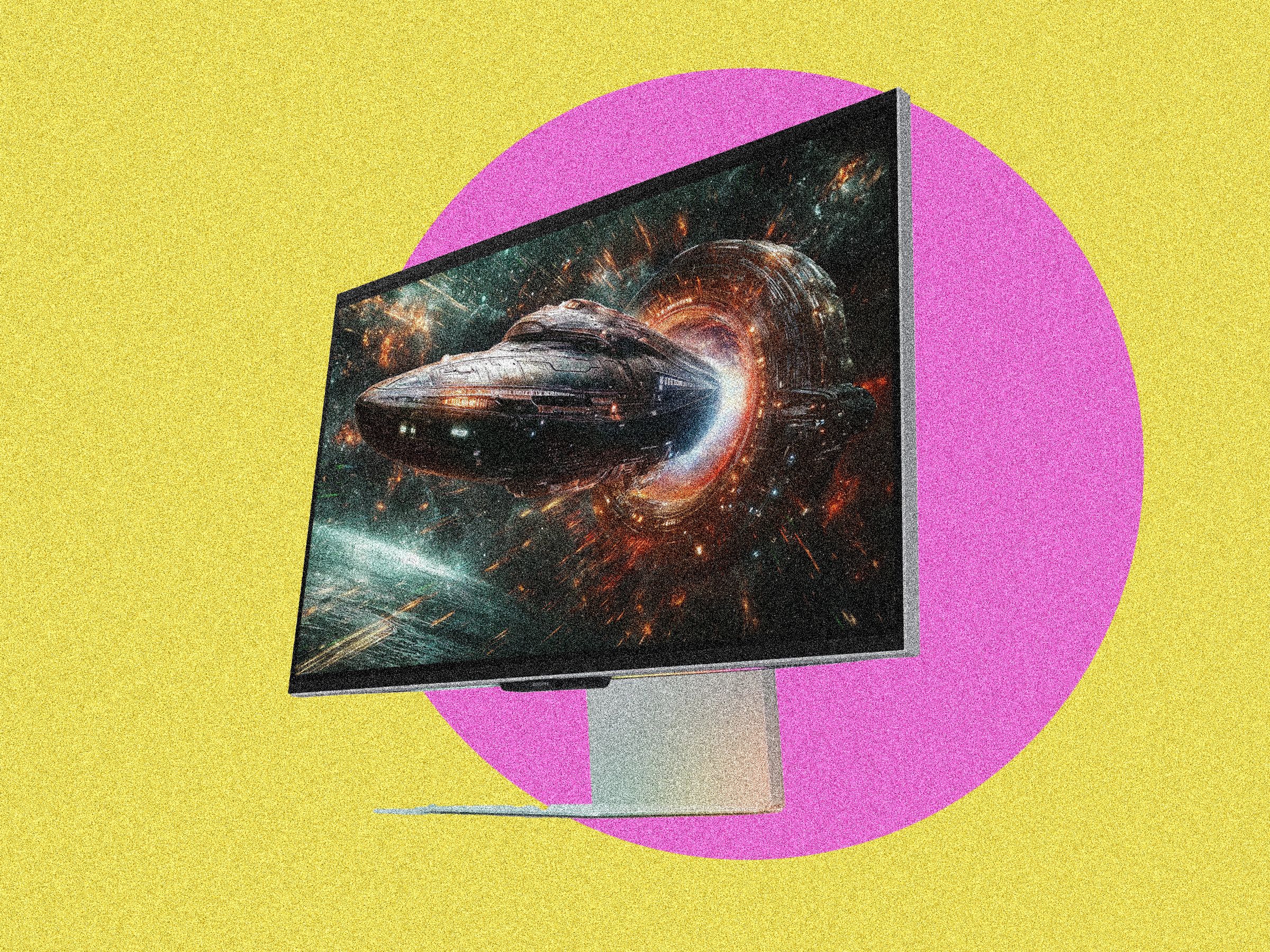There have always been two major issues with 3D displays: No one wants to wear 3D glasses, and there has never been enough content to take advantage of the technology.
Samsung’s new Odyssey 3D monitor (G90XF) wants to solve these problems in one fell swoop. It uses a lenticular lens and eye-tracking cameras to create a convincing 3D effect to bring PC games to life. It costs a hefty $2,000, a steep price considering how good (and affordable) gaming monitors are nowadays, but the Odyssey brings the 3D technology to the PC in a way that feels like the future we’ve always dreamed of.
Seeing Is Believing
Photograph: Luke Larsen
You can’t capture or see 3D with just a camera, and that’s one of the biggest challenges in describing the experience of using the Samsung Odyssey 3D. You do have to see it with your own eyes to believe it. While that can be true of other important monitor technologies, whether it’s resolution, refresh rate, or HDR, 3D is something everyone will want to try at least once.
If you’ve seen a movie in 3D, you get the idea. Your eyes are tricked into thinking the images are moving toward you in three dimensions. Elements in a game, such as a character or even a dialog window, spring off the screen. The system uses the 3D cameras to not only track your head movement, but predict it. That’s the secret sauce in providing a wider “sweet spot” for the 3D to stay in effect. The recommended distance is between 27 and 40 inches, which gives you lots of wiggle room to get comfortable. It’s possible to sit too close or far away, but I never felt like I had to stay still or compromise my comfort to stay in view.
That’s a big step forward from where this technology was just a few years ago, though there are still limitations. You can’t have multiple people in front of the monitor at once, and there are both resolution and PC hardware requirements to be aware of. You have to play the game at full-screen in native resolution, and you’ll need at least an Nvidia RTX 3070 graphics card. That rules out many lesser-powered PCs, as well as AMD video cards. You also need to have HDR turned off to play games in 3D.
Photograph: Luke Larsen
The biggest limitation, though, is game support. A mere 12 titles are supported officially, and they aren’t well known. There are a couple of popular games like Palworld and Stray, but they also include several lesser-known kids’ games like The Smurfs: Dreams and SpongeBob SquarePants: The Cosmic Shake. Only The First Berserker: Khazan is labeled as a “co-developed” title. Samsung has been light on details as to what this certification indicates, but unlike the other 11, the developer had to be involved in the 3D implementation in some sense. Samsung promises that there will be 11 more of these “co-developed” releases by the end of the year and as many as 50 generally compatible 3D games.
While that’s a good on-ramp, Samsung is attempting to catch up with the vast library of compatible titles in Acer’s SpatialLabs ecosystem in support of its Predator SpatialLabs View 27 and other 3D display products. Acer has been building that library for years, so there’s a large, notable disparity. On the other hand, the quality of what Samsung has achieved, specifically with the experience in The First Berserker: Khazan, is a step ahead of anything I’ve seen. At the very least, Samsung should be selling this bundled with a free copy of that game, given the highly limited game selection.
A Silver Beauty
Photograph: Luke Larsen
The Samsung Odyssey 3D isn’t the first of its kind, but it’s the one that feels most like a legitimate product. It’s a gorgeous monitor, using a silver chassis similar to the ones on other Odyssey monitors I’ve enjoyed. While it’s an experimental concept monitor for gamers, Samsung has done a fantastic job of making it appear like a standard screen. Yes, it has a wide stand and a large top bezel for its eye-tracking cameras, but other than that, you wouldn’t assume this is an early-adopter product. That’s unlike the aforementioned Acer Predator SpatialLabs View 27, which doesn’t look or feel nearly as high-end.
The setup is fairly simple, though it requires a few things to get started. First off, you need the Reality Hub app launcher to actually play games in 3D. It’s too bad it requires a separate app, but the software at least will scan your game libraries and display any supported games. Beyond that, you’ll need to plug in the attached USB-A cable, along with whatever you’re using for the display itself. I hooked it up to a gaming laptop, and it worked fine.
Photograph: Luke Larsen
You’ll find the ports on the monitor around the back, which offer the bare minimum, including two HDMI ports, DisplayPort, and two USB-A downstream ports. No headphone jack and no USB-C. On the right of the port array, you’ll find the power button, which also serves as the controls for the OSD (on-screen display). The menu is fine, though I was annoyed by how many clicks it took to get to brightness or volume controls.
It comes with a pair of 5-watt speakers, which are decent but not anything special. They have “directional sound,” giving sound effects some added immersion. However, in my test period, the audio was clearer and fuller with the 3D spatial speakers of the Acer monitor.
Quality Where It Counts
You’ll buy this monitor for its 3D capabilities, but in reality, you’ll use it in standard 2D far more often. That’s why Samsung was smart to ensure it didn’t compromise on the quality of the display. While I do hope an OLED is introduced in the future, the Odyssey 3D uses a high-quality 4K IPS panel with a 165-Hz refresh rate to make sure that gaming in 2D is still an enjoyable experience.
Color coverage is solid (100 percent sRGB, 83 percent AdobeRGB), and color accuracy is excellent. I measured it at 0.83 with my colorimeter, comparable to OLED panels. In SDR, this is also a brighter panel than most OLEDs, reaching 487 nits of max brightness. It won’t be nearly as impressive in HDR, but as it turns out, 3D games aren’t supported in HDR anyway. Suffice to say, it’s a solid 4K gaming monitor on its own—if only it weren’t for the exorbitant price.
Photograph: Luke Larsen
But the point is 3D, and I tried out a number of the compatible games, including Palworld, GTA: San Andreas, Stray, and SpongeBob. Each game I tried utilizes the 3D effect well enough, though you’ll run across some cutscenes or in-game situations that don’t work well, such as the opening sequence of GTA: San Andreas. You can dial back or pump up the 3D effect with simple keyboard commands. These games run on the Unreal Engine 4 engine, allowing Samsung to approve them without requiring additional developer work. Samsung hasn’t announced support for other game engines like Unreal 5 or Unity.
The real showcase of the technology is The First Berserker: Khazan. Samsung worked directly with the developer for the 3D integration, and the result is spectacular. The highly stylized action game shows just how much the 3D effect can add to the immersion of the game. In the opening sequence, the snow doesn’t just fall around the character—you’re right there in the flurry, soaking up the atmosphere in a way that isn’t possible in 2D. It’s less about the action of the game suddenly jumping toward you—like you might expect in a 3D movie—and more about being submerged into the world. That’s important because in a game that requires your attention in battles, you don’t want the 3D elements to distract. After playing for 30 minutes, you’ll find yourself getting used to the extra dimension. If you’re like me, you won’t want to go back.
The 3D technology isn’t explicitly exclusive to games. The monitor can also convert 2D images and videos into 3D, which is fun to experiment with. There are several restrictions, such as the requirement to be in full screen and DRM-protected content. That means you won’t be watching full movies in 3D anytime soon.
But watching clips of films or trailers on YouTube shows just how promising it could be if Samsung can get around the DRM problem. So long as they are full screen and with only one other person, you can even use it on video calls, which I tried out. It’s pretty incredible, emulating something akin to a toned-down version of Google’s Project Starline.
The 3D conversion uses AI to create a depth map to predict where the layers of depth should be. As you may have guessed, it’s far from a perfect effect. You can see the AI slop fraying on the edges, and the level of depth is nowhere near as lifelike as it is in games. It also soaks up some performance, causing the Razer Blade 16 I was using to kick its loud fans on.
An Exciting Future
No one should rush out and buy the Samsung Odyssey 3D. It’s expensive, and the list of compatible titles is embarrassingly small. At $2,000, you’ll pay a lot for the privilege of testing out the tech. With how good gaming monitors are nowadays, you’re paying well over $1,000 for the 3D here. Most people should buy an incredible OLED gaming monitor, which costs roughly $800.
I can’t help but be excited by it. For me, it was not unlike trying out virtual reality for the first time. 3D is not nearly as immersive, but not requiring a headset or glasses feels like magic. While I’m not sure I’d want to play every game in 3D, there’s so much less fatigue, making this a more practical technology over anything wearable. This monitor has made me genuinely excited about the future of 3D displays. While I wait for a future where the entire Windows operating system can be navigated in 3D—both in games and not—the Samsung Odyssey 3D monitor feels like a glimpse into the future.
It won’t be the last of this technology, as Samsung tells me. (Samsung hosted WIRED at a media event in Seattle and paid for a portion of our reporter’s travel expenses. We received a review unit shortly after.) If you’re only marginally interested, you shouldn’t have to wait too long before we see some (hopefully) more affordable options on the market.




